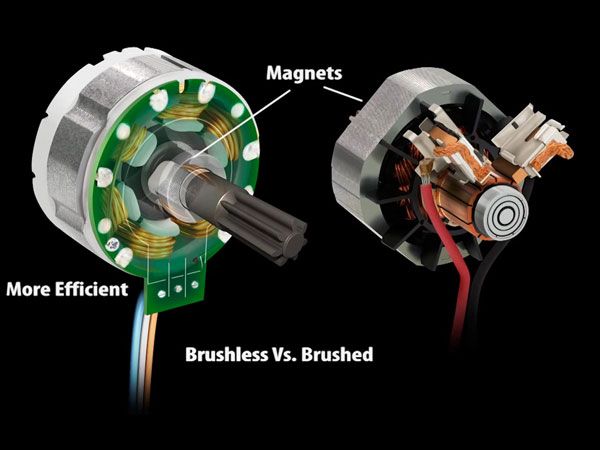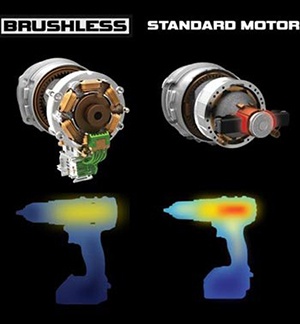Hey there! Let’s talk about what it means when a power tool is described as “brushless.” So, what does brushless mean for power tools? Well, in a nutshell, it’s all about efficiency and performance. 🛠️💥
When a power tool is brushless, it means that it operates using a different type of motor, one that doesn’t have brushes. These brushes in traditional motors can wear out over time and can cause friction, heat, and even power loss. That’s where brushless technology comes in to save the day! 💪✨
With brushless power tools, you can expect longer runtimes, increased power, and overall better performance. The absence of brushes means less energy loss and less heat generated, leading to a more efficient and reliable tool. So, whether you’re a DIY enthusiast or a professional tradesperson, brushless power tools are definitely worth considering for your next project. Let’s dive in and learn more! 🚀🔧
Have you ever wondered what “brushless” means for power tools? Brushless power tools have become increasingly popular in recent years due to their superior performance and longevity. Unlike traditional brushed motors, brushless motors use electronic circuitry to drive the tool, resulting in higher efficiency, longer battery life, and more power. Brushless power tools also generate less heat and have reduced maintenance needs. So the next time you’re in the market for new power tools, consider the benefits of brushless technology!

What Does Brushless Mean for Power Tools?
Brushless motor technology has revolutionized the world of power tools, offering increased efficiency, durability, and performance. Whether you’re a professional contractor or a DIY enthusiast, understanding what “brushless” means for power tools can help you make informed decisions when purchasing new equipment. In this article, we will explore the benefits of brushless technology, compare it to brushed motors, and provide tips for maximizing the potential of brushless power tools.
The Advantages of Brushless Technology
1. Improved Efficiency: Unlike traditional brushed motors, brushless motors utilize electronic commutation to eliminate physical brushes. This results in less friction and greater energy efficiency, leading to longer battery life and extended tool runtime. With brushless power tools, you can accomplish more tasks without having to frequently recharge or replace batteries.
2. Increased Power and Performance: Brushless motors are designed to deliver maximum power output. They offer higher torque, faster rotations per minute (RPM), and better overall performance compared to their brushed counterparts. This means you can tackle tougher materials and complete tasks faster with brushless power tools.
3. Enhanced Durability: Since brushless motors don’t have brushes, there is no mechanical wear and tear that occurs over time. This makes brushless power tools more durable and reliable, able to withstand heavy use without compromising performance. With a longer lifespan, these tools can provide value for your investment.
Brushless vs. Brushed Motors: A Comparison
While brushed motors have been widely used in power tools for many years, brushless motors have quickly gained popularity due to their superior performance. Here are some key differences between these two types of motors:
1. Efficiency:
Brushed motors rely on brushes to channel electrical current to the armature, resulting in friction, heat generation, and energy loss. On the other hand, brushless motors use electronic commutation, eliminating the need for brushes and reducing energy wastage. This makes brushless motors more efficient and less prone to overheating.
2. Power and Performance:
Brushless motors offer higher power output, increased torque, and faster RPMs compared to brushed motors. This translates to better performance and the ability to handle more demanding tasks. Brushless power tools excel in applications that require high power and precision.
3. Durability and Maintenance:
Brushed motors have mechanical brushes that wear down over time, requiring replacement. In contrast, brushless motors have no physical brushes, resulting in reduced maintenance needs and longer tool lifespan. Brushless power tools are built to withstand heavy use and demanding conditions.
Choosing and Using Brushless Power Tools
When selecting brushless power tools, it’s important to consider factors such as the tool’s voltage, battery compatibility, and additional features. Here are some tips to help you make the most of your brushless power tools:
1. Battery Selection:
Ensure that the brushless power tool you choose is compatible with high-quality lithium-ion batteries. These batteries provide consistent power delivery, longer runtime, and faster charging times. Invest in extra batteries to avoid interruptions during prolonged tasks.
2. Understanding RPM Ratings:
Pay attention to the RPM rating of brushless power tools. Higher RPM values indicate faster drilling, cutting, or grinding speeds. Consider the specific tasks you’ll be performing and choose a tool with an RPM range that meets your needs.
3. Utilizing Electronic Controls:
Many brushless power tools come with electronic controls that allow you to adjust settings and customize performance according to the task at hand. Familiarize yourself with these features and take advantage of them to optimize your tool’s performance.
The Future of Brushless Technology
As technology continues to advance, the future of brushless power tools looks promising. We can expect even greater efficiency, power, and durability from brushless motors. Manufacturers are constantly improving these tools and incorporating new features to meet the evolving needs of professionals and DIY enthusiasts. Stay informed about the latest advancements in brushless technology to make the most informed decisions when it comes to your power tool investments.
Key Takeaways: What Does Brushless Mean for Power Tools?
- Brushless power tools are more efficient and have improved performance compared to traditional brushed tools.
- Brushless motors use magnets to generate power, eliminating the need for brushes and commutators.
- Brushless tools have longer run times due to reduced friction and heat.
- Brushless tools require less maintenance as there are no brushes to replace.
- Brushless power tools are often more expensive initially but can provide better long-term value.
Frequently Asked Questions
Brushless power tools have become increasingly popular in recent years, but what exactly does “brushless” mean for these tools? In this section, we’ll address some common questions surrounding brushless power tools.
1. How do brushless power tools differ from brushed power tools?
Brushless power tools and brushed power tools differ in terms of how they generate power. Brushed tools rely on a carbon brush and commutator to deliver power to the motor. This results in friction and wear over time, leading to reduced efficiency and motor life.
In contrast, brushless power tools use an electronic circuit to deliver power to the motor, eliminating the need for brushes and commutators. This design offers several advantages, including improved efficiency, increased power output, and longer tool life.
2. What are the benefits of using brushless power tools?
Using brushless power tools comes with several benefits. One major advantage is their increased efficiency. Brushless motors have a higher power-to-weight ratio, meaning they can deliver more power while consuming less energy.
Additionally, brushless power tools tend to have a longer lifespan compared to brushed tools. Since there are no brushes or commutators that can wear down, the motor’s wear and tear are significantly reduced. This leads to a longer tool life and fewer maintenance requirements.
3. Do brushless power tools provide better performance than brushed tools?
Brushless power tools generally offer better performance compared to brushed tools. The absence of brushes reduces friction, which allows brushless motors to operate at higher speeds and generate more torque. This results in faster and more efficient tool performance, making brushless power tools ideal for demanding tasks.
Furthermore, brushless tools often have advanced electronic controls that optimize the power delivery to match the workload. This intelligent control system enhances overall performance and helps prevent overheating or overloading.
4. Are brushless power tools more expensive than brushed tools?
Brushless power tools tend to be more expensive upfront compared to brushed tools. The advanced technology and higher-quality components used in brushless motors contribute to the higher price tag. However, it’s important to consider the long-term benefits of brushless tools.
Due to their increased efficiency and longer lifespan, brushless power tools can offer a better return on investment over time. They require less frequent maintenance and replacements, saving both time and money in the long run.
5. Can brushless power tool batteries be used interchangeably with brushed tool batteries?
Unlike brushed power tools, brushless power tools typically require a specific battery system designated for brushless models. The battery systems for brushed and brushless tools are not interchangeable. This is because brushless tools often require higher voltage and different electrical configurations to fully utilize their advanced motor technology.
It’s crucial to use the recommended battery for your brushless power tools to ensure optimal performance and avoid potential damage to the tool or battery.

Summary
You might be wondering what “brushless” means when it comes to power tools. Well, it’s actually quite simple. Brushless power tools are more efficient, run longer, and require less maintenance compared to their brushed counterparts. They use magnets to create power, saving energy and giving you more power in your hands. Plus, they tend to last longer, making them a great investment for any DIY enthusiast or professional. So, next time you’re in the market for a power tool, consider going brushless for a smoother and more powerful experience.
In summary, brushless power tools are the way to go if you want better performance and less hassle. They are more efficient, durable, and powerful, thanks to their magnet-powered technology. So, whether you’re working on a project at home or on the job site, choosing a brushless power tool will make your life easier and your work more efficient.
